A day before they’re set to kick off their 2023 Africa Cup of Nations group stage campaign versus South Africa, we’ve opted to highlight Éric Chelle’s Mali as our team to watch in this year’s tournament.
Chelle’s side suffered a blow in the months leading up to the competition, with their star striker from LaLiga’s Almería, Ibrahima Koné, being ruled out of action for five months back in October due to a fractured ankle. Consequently, the 24-year-old is not part of Chelle’s final 27-man squad.
Still, the Malian faithful can hold high hopes ahead of their opening game, thanks to their youthful, energetic, in-form squad.
Les Aigles enter AFCON as Africa’s ninth-highest-ranked side as per the current FIFA World Rankings. They’ll face one of the eight teams ranked higher than them, Tunisia, in Group E, while neither South Africa nor Namibia will be pushovers.
However, having finished the qualification campaign with, overall, the fourth-highest xG (10.96), second-most goals (15) and second-fewest goals conceded (two), all while averaging the fifth-youngest squad (25.9) on the continent, a degree of optimism may be warranted for fans of the nation that’s failed to progress beyond the Round of 16 in any of the last four AFCON tournaments, since the 2013 edition.
This tactical analysis piece will provide in-depth insight into what you can expect from Éric Chelle’s side when they take to the pitch for the first time in the 2023 Africa Cup of Nations versus South Africa tomorrow evening and throughout the tournament. We’ll share some analysis of Chelle’s tactics while pinpointing key players you need to watch out for within his 27-man squad.
Beware of Mali’s midfielders and penetrating play in possession
Having enjoyed a fruitful AFCON qualification campaign in front of goal, let’s kick off this tactical analysis by diving into how Chelle’s side tend to score their goals and create their chances.
Mali’s midfield is undoubtedly a strong area of their team, with several quality players, such as Yves Bissouma of EPL Tottenham Hotspur, Mohamed Camara of Ligue 1 AS Monaco, Aliou Dieng of 2023 CAF Champions League winners Al Ahly, Amadou Haidara of Bundesliga RB Leipzig and Diadie Samassékou from TSG Hoffenheim of the same league among the options vying for a place in the starting XI.
We’ll likely see all of the above featuring in some capacity throughout the tournament, with Camara and Dieng the two most likely to feature in the starting XI as a duo if Chelle opts for the 4-2-3-1 he’s sometimes used. On current form, there’s a strong case for Bissouma to feature if it’s a three-man midfield (Chelle often sets his team up in a 4-3-3 or 4-3-1-2), though he could just as likely be deployed on the wing in a 4-2-3-1 or 4-4-2, as is the case with Haidara; Samassékou has been a common starter under Chelle as well, particularly in a three-man midfield.
You could expect to see Camara holding more often while Dieng will get forward a bit more either in a two or three-man midfield. Bissouma would also typically prefer to exploit the more advanced spaces, but the midfield contains players of high quality who will be sure to cover for one another and sit deeper should one see it fit to progress into a more advanced position.
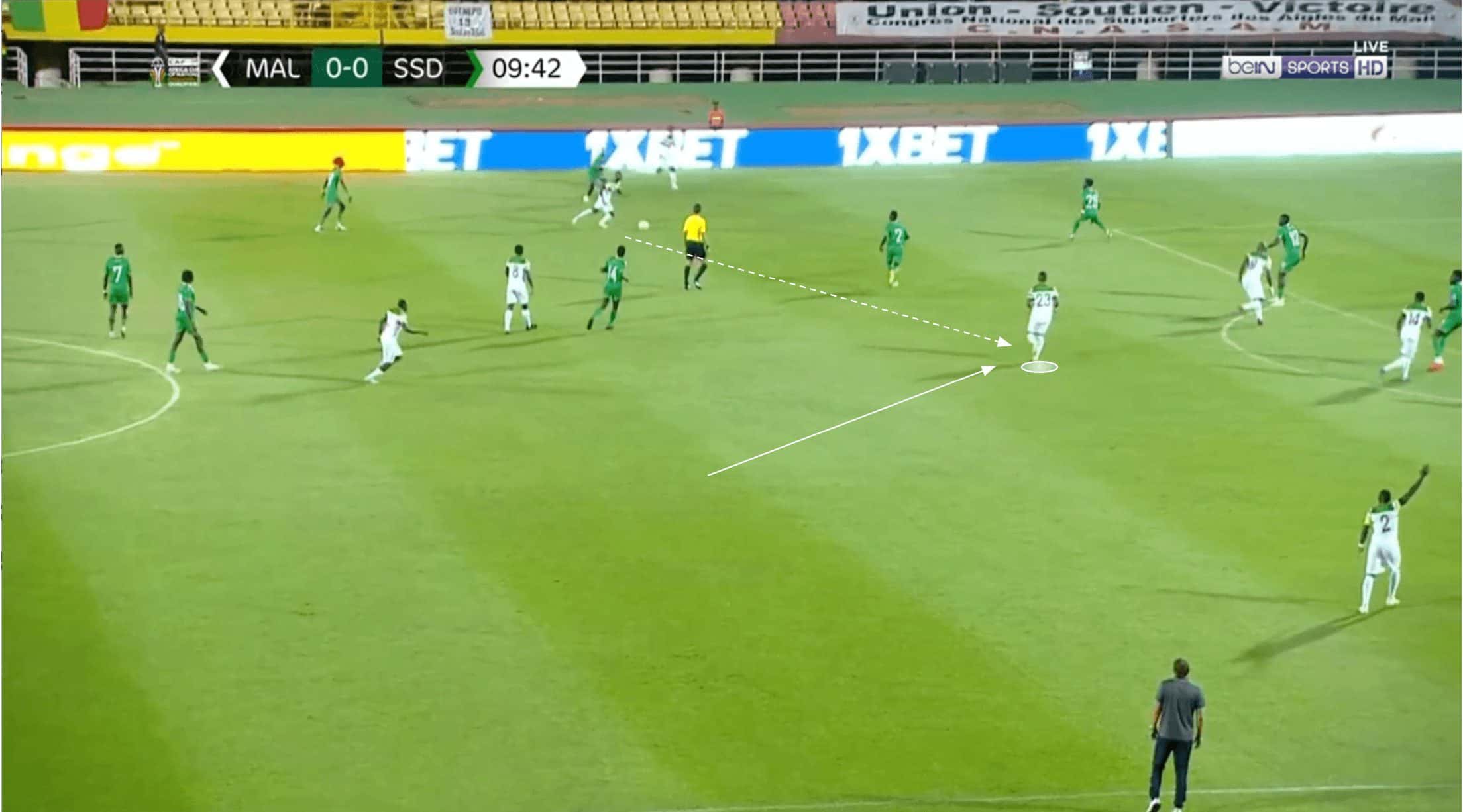
In this case, showcasing an example from Mali’s AFCON qualification clash with South Sudan back in September, Dieng advanced into some space in ‘zone 14’ from right central midfield after the opposition’s midfielder previously covering that space was attracted to the ball-carrier progressing on the left. As Dieng moved forward, Camara remained deep, shifting slightly to the right, while Samassékou also provided cover.
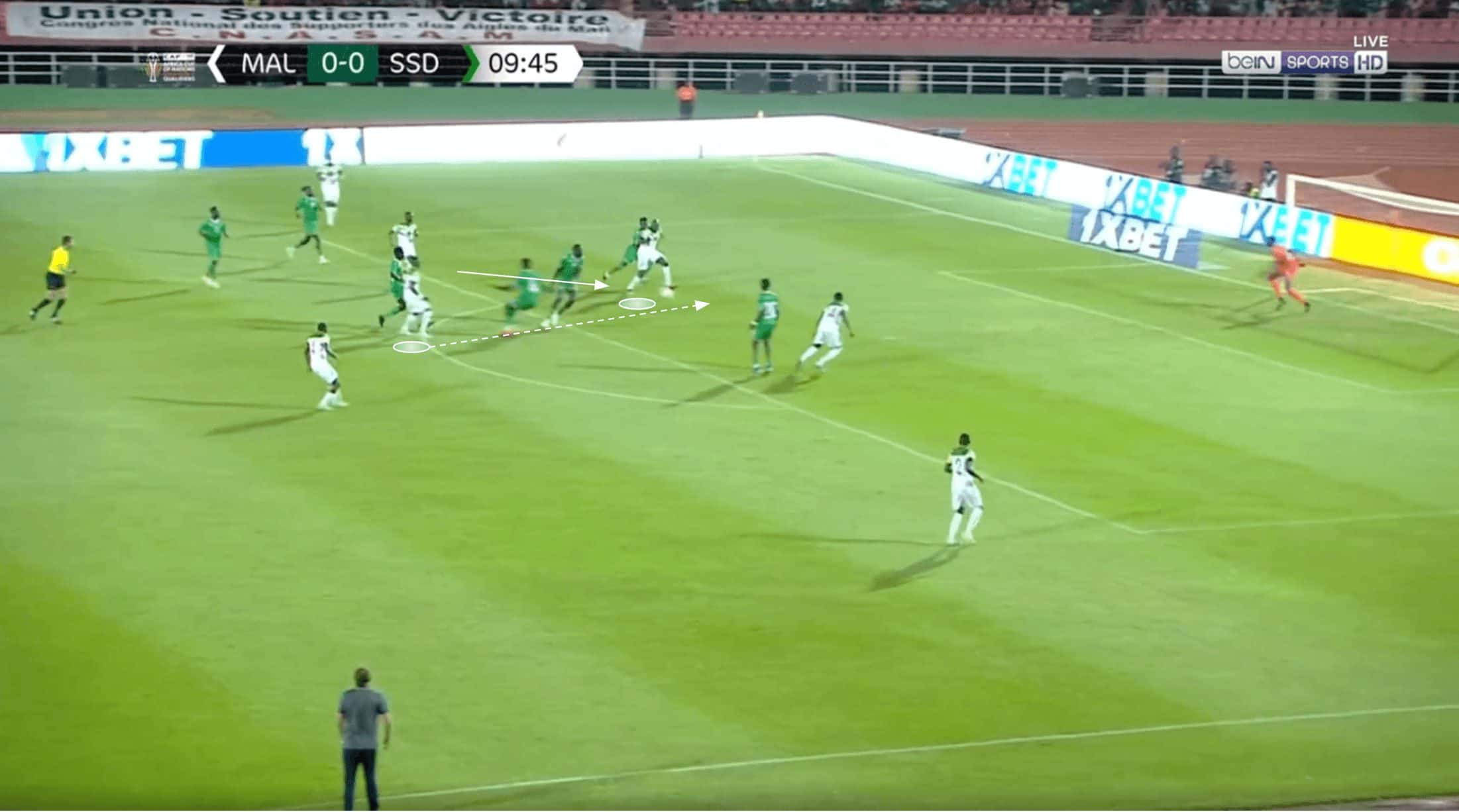
The Malian ball carrier from the left managed to find Dieng in this dangerous position, which allowed the Al Ahly midfielder to spring a defence-splitting through ball in behind the South Sudanese backline, playing Ibrahima Koné in to put his side one goal to the good.
The midfield coordination and teamwork to find and exploit space, along with providing necessary cover for one another, is a constant positive within this Malian side — a result of the quality and top-level experience each member of the midfield routinely displays evidence of.
Furthermore, this attack highlights the runs in behind and defence-splitting passes that are also commonplace in Chelle’s team, both from advanced positions like the pass from Dieng here and deeper positions, as our next example shows.
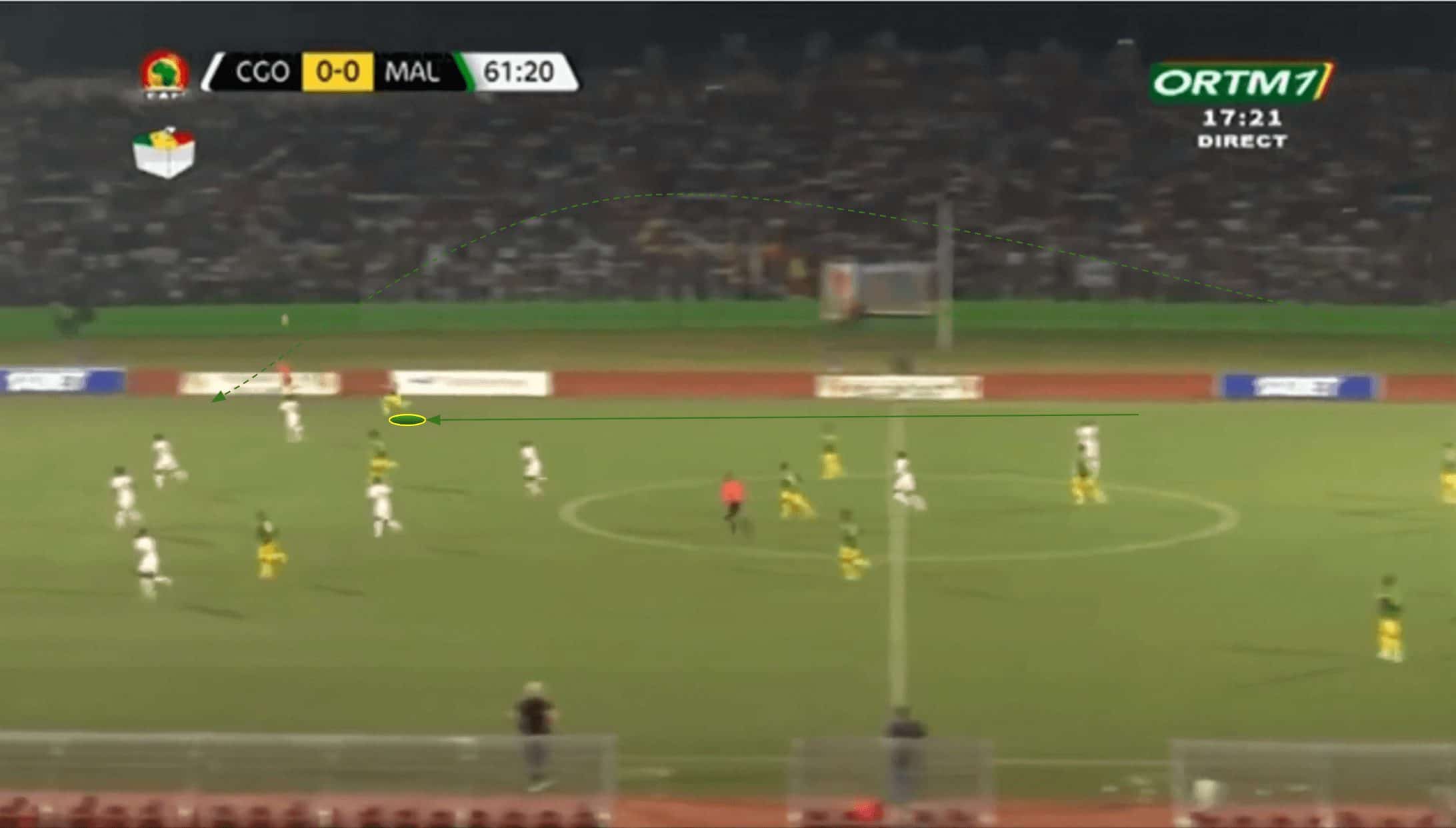
In figure 3, we see right-back Hamari Traoré chasing a ball over the top from the goalkeeper, targeting space behind the opposition’s left-back. Expect to see Mali captain Traoré frequently driving forward, providing width for his side in the final third — especially when his team deploys the 4-3-1-2 as they did in this game when they lack natural width in advanced positions.
The key thing to note right now, though, is the long ball directly targeting a Malian runner driving in behind the opposition’s defensive line. This is not a one-off; we often see Mali’s attackers making these runs for balls in behind even when their team is in possession of the ball deep, with the team clearly keen to spring balls in behind and over the top quickly, not wasting time to put the opposition’s backline under pressure.
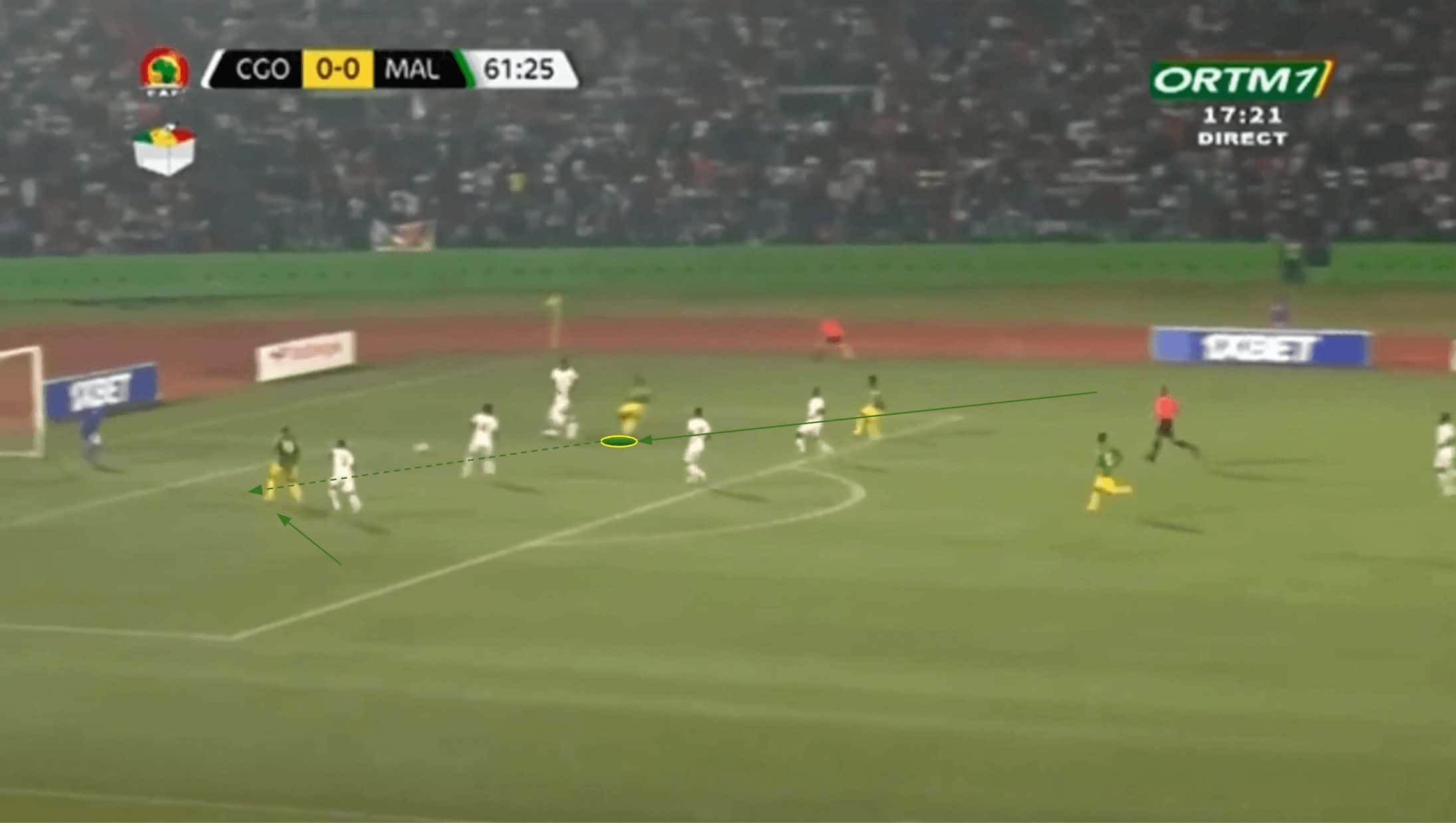
In this case, we see Traoré get on the end of the long ball, beat the opposition left-back and put the ball on a plate in an excellent position for Ibrahima Koné to finish and put his side ahead.
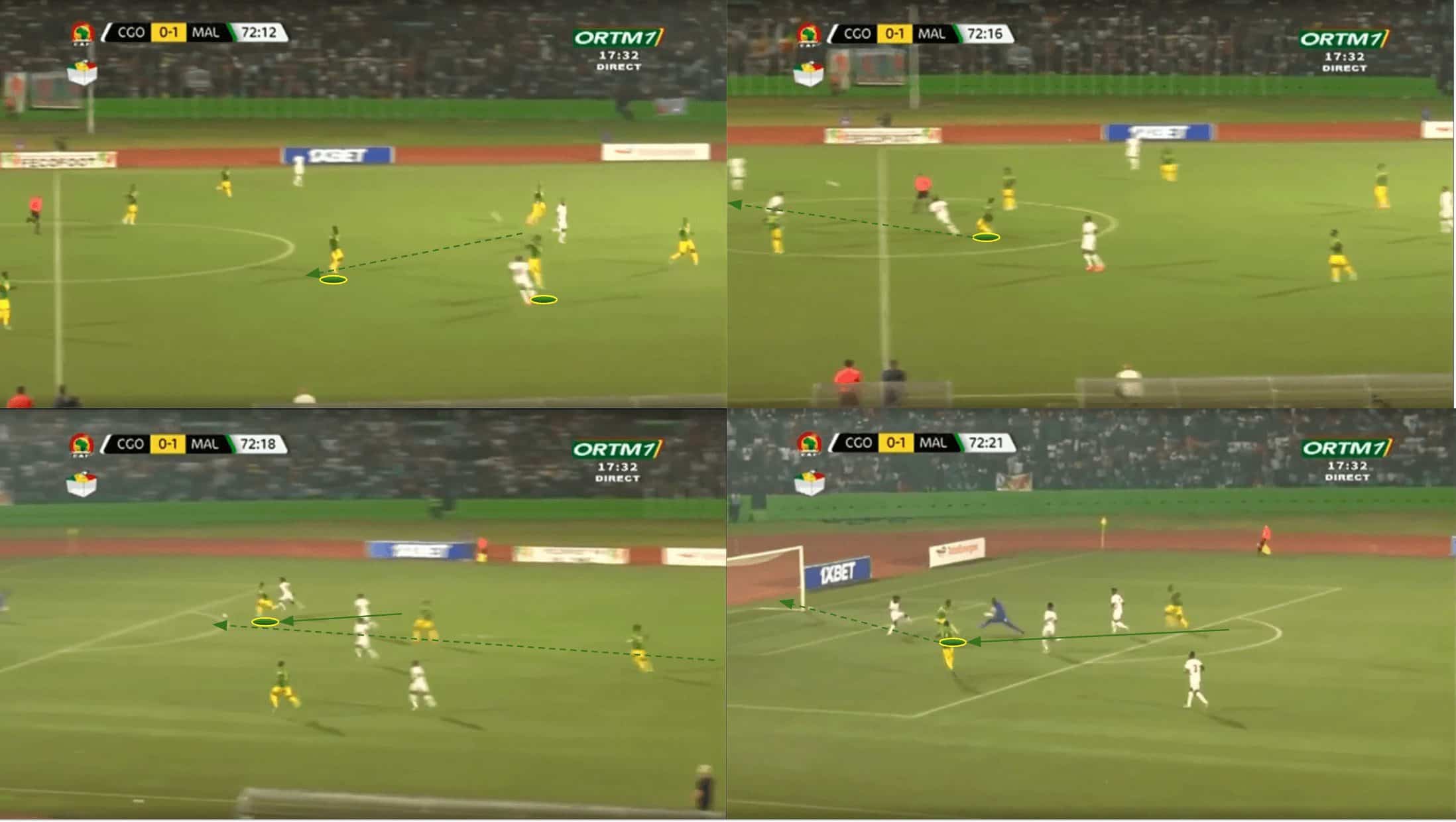
Later on in the same game, we caught another glimpse of Mali’s direct play, this time on the counter. Mali won the ball in central midfield following the opposition’s goal-kick. As it’s headed down for Amadou Haidara, the Leipzig-based midfielder quickly turns, gets his head up and spots the run of Red Bull Salzburg’s Nene Dorgeles, who rounds the opposition goalkeeper and slots the ball home into an empty net to put his country two goals up.
Haidara knew precisely where to look and what pass would be on as Mali frequently try to exploit space in behind early, both from settled possession phases and in transition to attack, via quick balls in behind from deep and attackers who are willing to make early runs targeting that space in behind.
As Congo found out in this fixture and as South Sudan discovered back in figures 1-2, Mali’s quality midfielders can’t be given much time and space in these dangerous positions, as they will break the defence open with their technical quality and vision to create glorious chances for their side. If they’re given that space in the tournament properly, expect to see Chelle’s side continue their form in front of the goal as they will continue to create lots of goalscoring opportunities.
Suppose the chances to split lines and create aren’t on. In that case, this midfield is also well capable of retaining possession and working the ball into those advanced positions more methodically, but they’ll always have their eye on that opportunity to flick the switch and play someone in behind — early or in the final third; they certainly can’t be allowed the space they were in these examples.
Aggression and flexibility out of possession
Moving on to looking at Mali’s approach without the ball, we can categorically say that, again, they are a formidable outfit, as their stellar record from the AFCON qualification campaign would suggest.
Chelle’s side tend to press high, looking to force turnovers in advanced areas that can, in turn, lead to dangerous opportunities from high-quality positions. This is essentially a constant within their game plan.
However, they are incredibly flexible in terms of shape and will change things up regularly depending on the opponent.
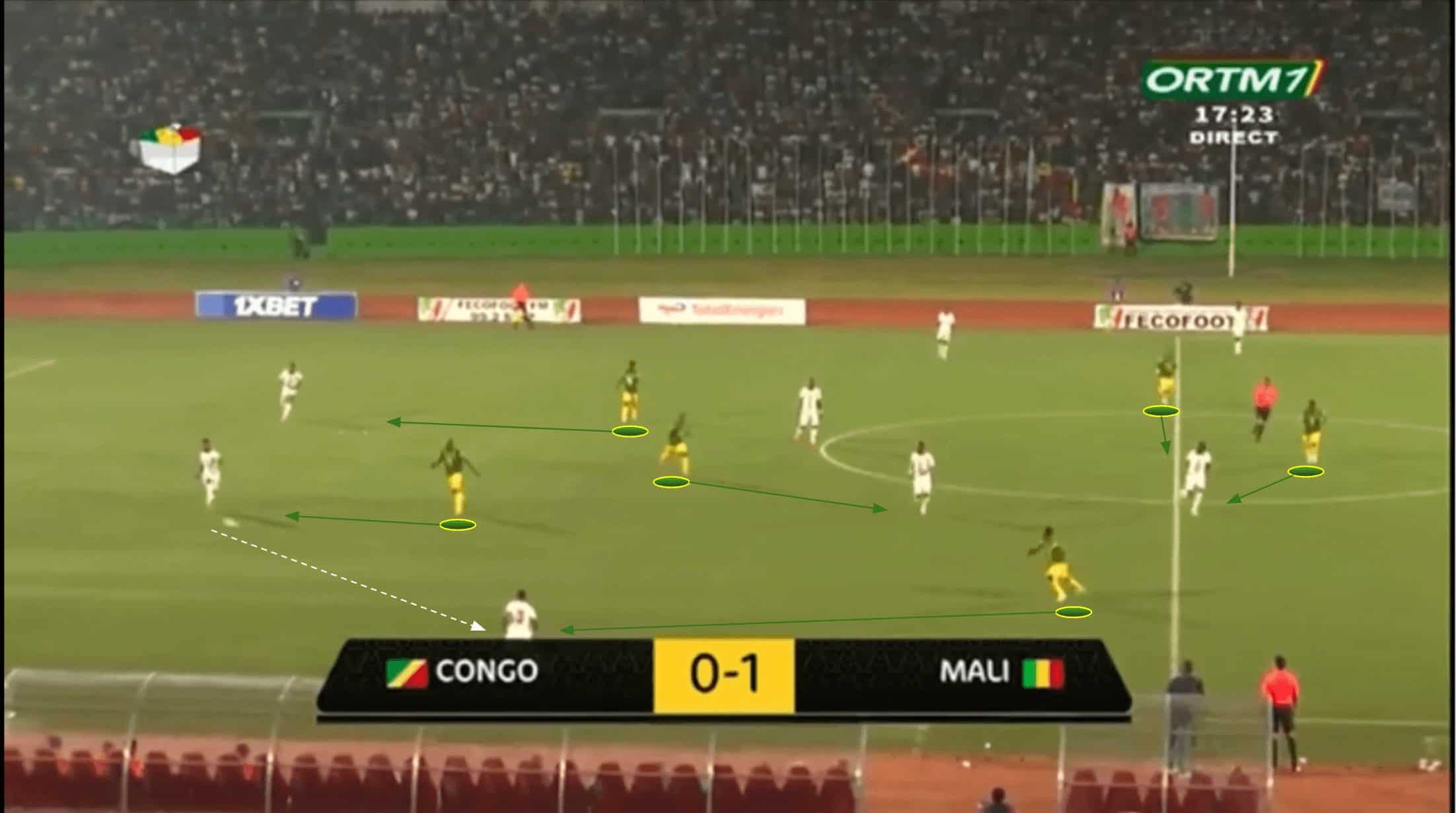
Against Congo, for example, they deployed something of a 4-diamond-2 (4-D-2) shape designed to create a constant central overload and force the opponent out wide where the ball-near central midfielder would be triggered to press aggressively. At the same time, the rest of the front six would shift across to cover that pressing player and mark the passing options behind him.
We see that exact process in action in figure 6.
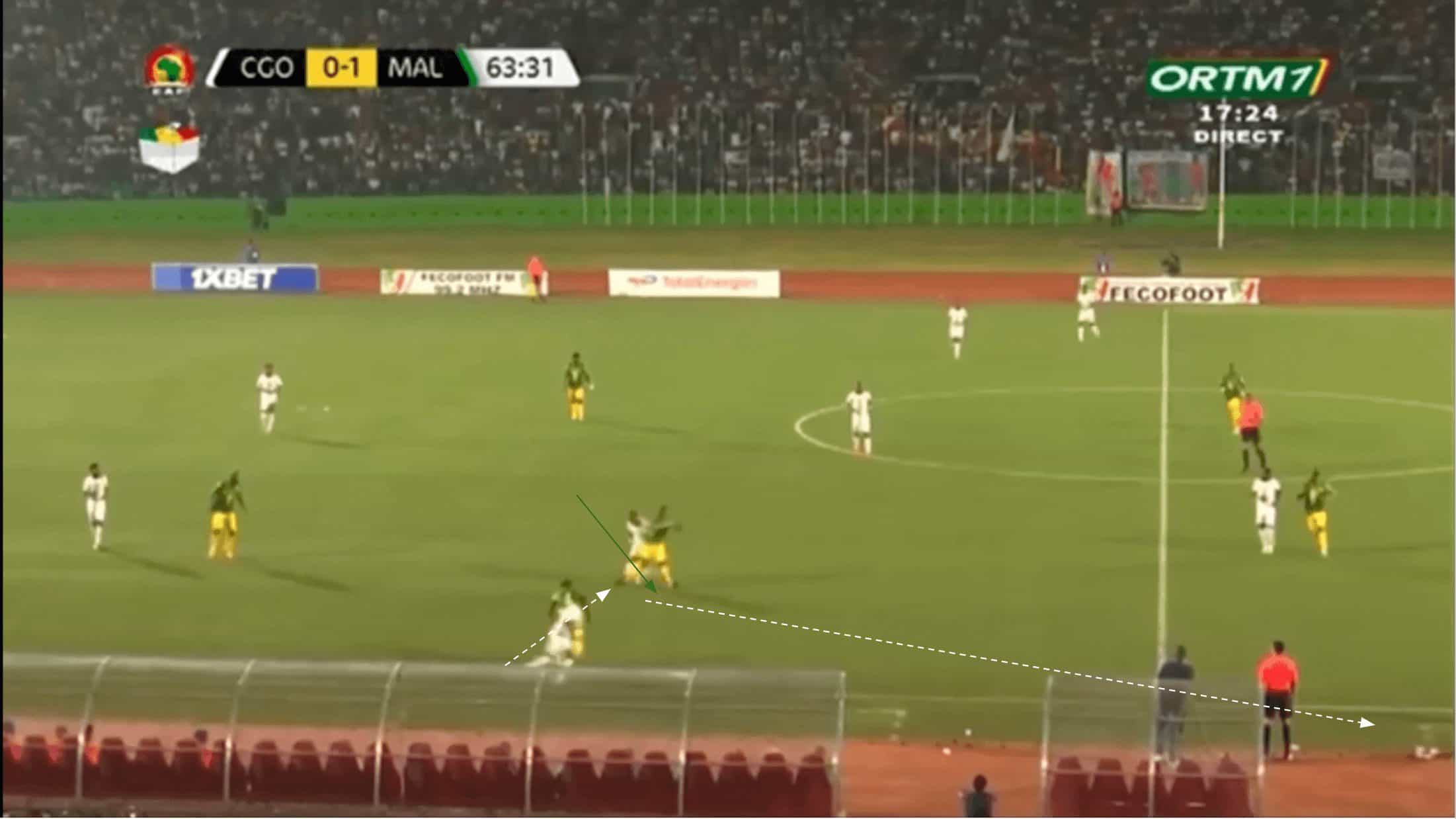
Moving on into figure 7, we see that the plan works well as Mali’s ‘10’, Kamory Doumbia — currently on loan at Brest from their Ligue 1 rivals Reims, puts enough pressure on Congo’s intended central receiver to ensure the next pass is misdirected and sent out of play at the halfway line for a Mali throw.
By deploying a 4-3-1-2, Mali prioritised control in the centre and ensured they always had a free man versus the opposition’s three-man midfield. This, along with some organised pressing and well-executed instructions, enabled them to force plenty of mid-high turnovers and ultimately stifle the opponent’s possession play, helping them to a 2-0 win away from home.
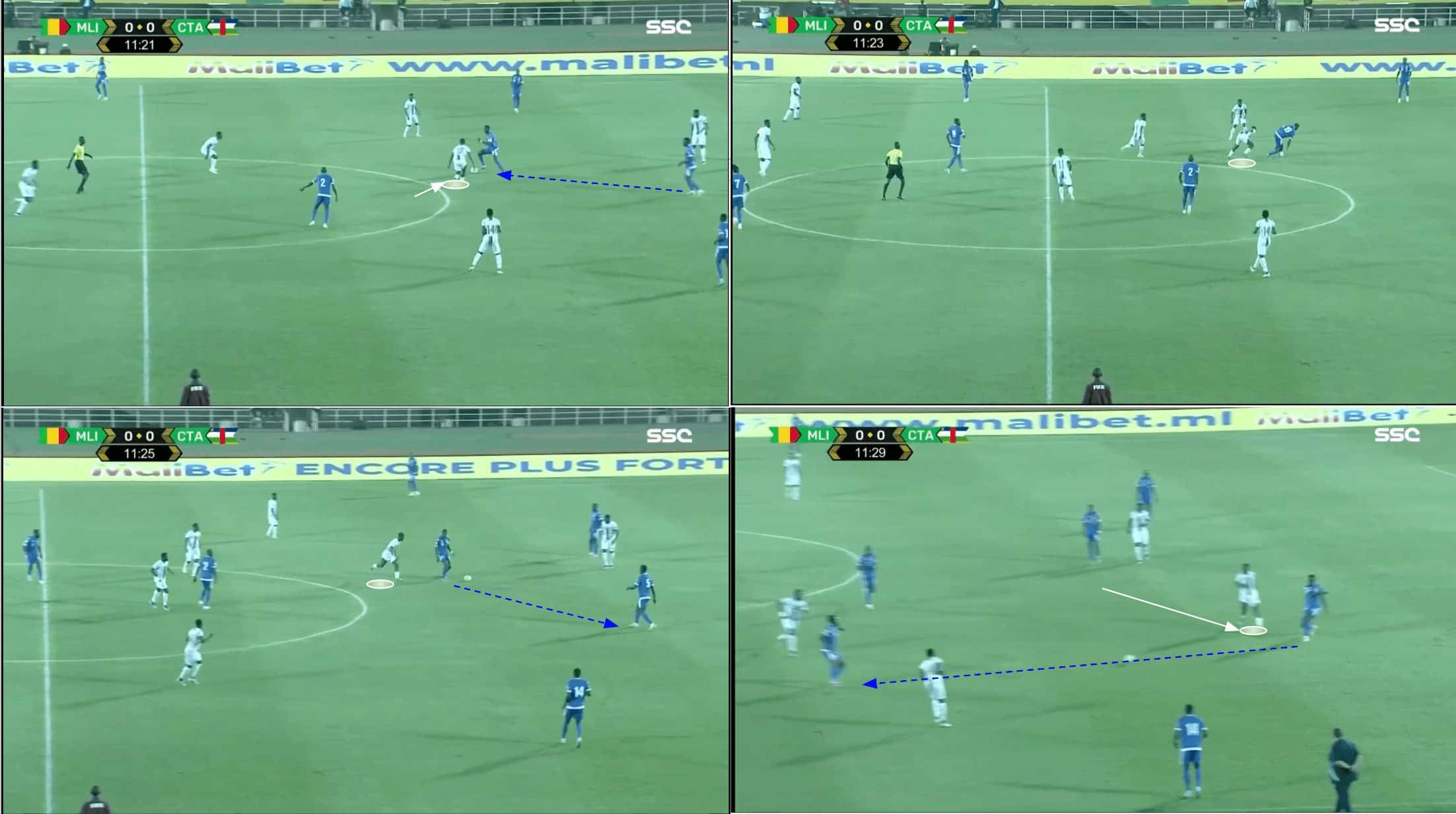
In a recent FIFA World Cup qualifier versus the Central African Republic, Mali used a 4-2-3-1 where the ‘10’, in this case, Bissouma, focused on man-marking the opposition’s deep-lying midfielder, Geoffrey Kondogbia, throughout the contest, identifying him as the key man in the opponent’s possession play.
Figure 8 shows an example of how Bissouma latched onto the Marseille midfielder as soon as he received, denying him the chance to progress through the middle of the park, forcing him backwards, and ultimately forcing the opponent to try and progress via alternative means.
In this case, the left centre-back, Sadock Ndobé, tries to play the ball into midfield, but the pass leaves the receiver a sitting duck to be dispossessed, leading to a turnover in favour of Mali inside the opposition’s half, creating a dangerous counterattacking opportunity for Chelle’s side — the type that the 46-year-old coach and his team work so hard to try and generate; the type that they so often convert into goalscoring opportunities.
In this case, Chelle put a man-marker on a key man of the opposition’s and went man-for-man in central midfield while committing more bodies into the forward line, providing his side with natural width in the final third they could use in transition to hurt the opponent.
So, Chelle and his team will approach each game with a clearly defined plan designed to target the opponent they face on that day, specifically. They’re flexible out of possession with an overarching goal of stifling the opposition in the early possession phases and generating high turnovers that they can use to create counterattacking opportunities.
The high-quality midfield, again, plays a crucial role in their success in the defensive phases; the team’s success at pulling off Chelle’s desired approach without the ball played a vital role in their successful qualification campaign and will make them a difficult team to play against in the tournament itself.
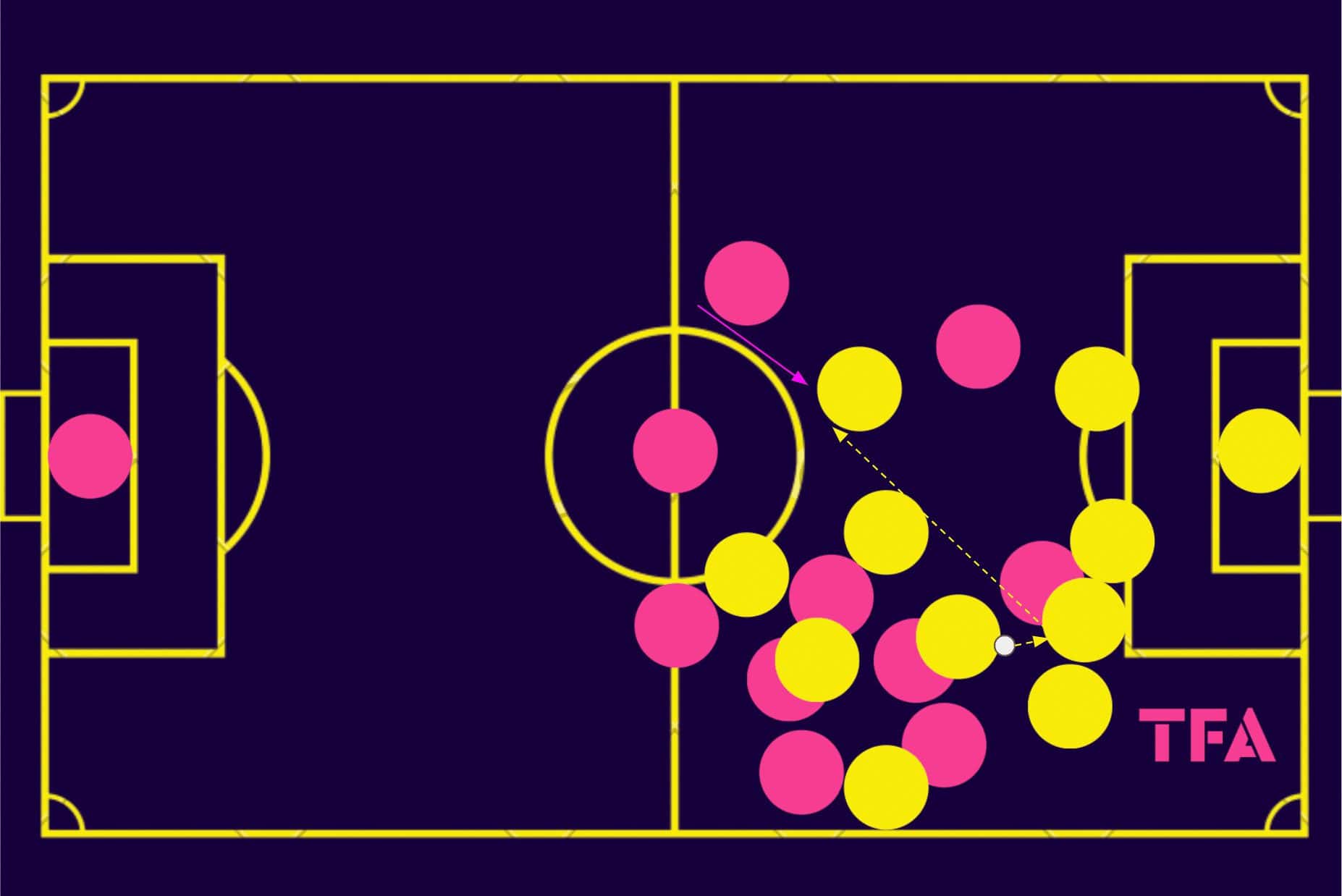
In defensive transitions, expect to see Mali counter-pressing quite aggressively a lot of the time, with Chelle’s side frequently counter-pressing in a space-oriented manner designed to almost cage the opponent into a particular corner of the pitch and deny them any way out.
Versus Central African Republic, this specific scenario (with Mali represented by the pink and their opponents represented by the yellow) occurred just after a loss of possession inside the opposition’s half, demonstrating again the targeting of Kondogbia and high pressing tactics.
As the midfielder gets forced back to the left centre-back behind him, the deep receiver manages to clear the ball in the direction of his right-winger.
However, as per the space-oriented pressing tactics being deployed, Mali’s left-back, in this case Massadio Haïdara, is already moving into more of a left central midfielder position to close down the would-be receiver. He succeeds in closing the player down, denying him the opportunity to turn and drive forward on the counter, creating a counterattacking chance for Mali instead.
This highlights how they often approach the defensive transition, with aggressive pressing and full-back movements, in particular, playing a vital role in shutting down hopes of the opposition to catch their opponents out in a vulnerable moment, turning the momentum on its head and generating yet another counterattack for Mali themselves when things go to plan, which they often did in AFCON qualification and other recent fixtures, such as this Central African Republic clash.
Key area to watch: Full-backs
As we stated when analysing their defensive transition above in figure 9, Mali’s full-backs and their knowledge of the movement required from them in that particular phase of play is crucial to its success. It’s not just in defensive transitions where Chelle’s full-backs play a particularly vital and intriguing tactical role, however.
We also noted how right-back and captain Hamari Traoré got forward in figure 3 to provide the attacking width on the right when his team was playing a 4-diamond-2 and lacking natural width in that area, again highlighting the versatility required of Mali’s full-backs depending on the game plan yet vital importance of how they execute that role.
Massadio Haïdara, the left-back who featured for Mali in that earlier-analysed Central African Republic clash, is out of AFCON due to injury but will likely be replaced by another capable option in 23-year-old Sturm Graz left-back Amadou Dante, who featured a decent amount on the opposite side of defence to captain Traoré during the successful AFCON qualification campaign.
Dante has demonstrated the ability to carry out the roles required of him within Chelle’s team and should keep the quality high in what is; it can’t be understated, a crucial part of this side both in and out of possession, where the players are required to be aggressive with and without the ball, getting up and down the pitch, making the right movements at the right times and demonstrating a lot of tactical intelligence.
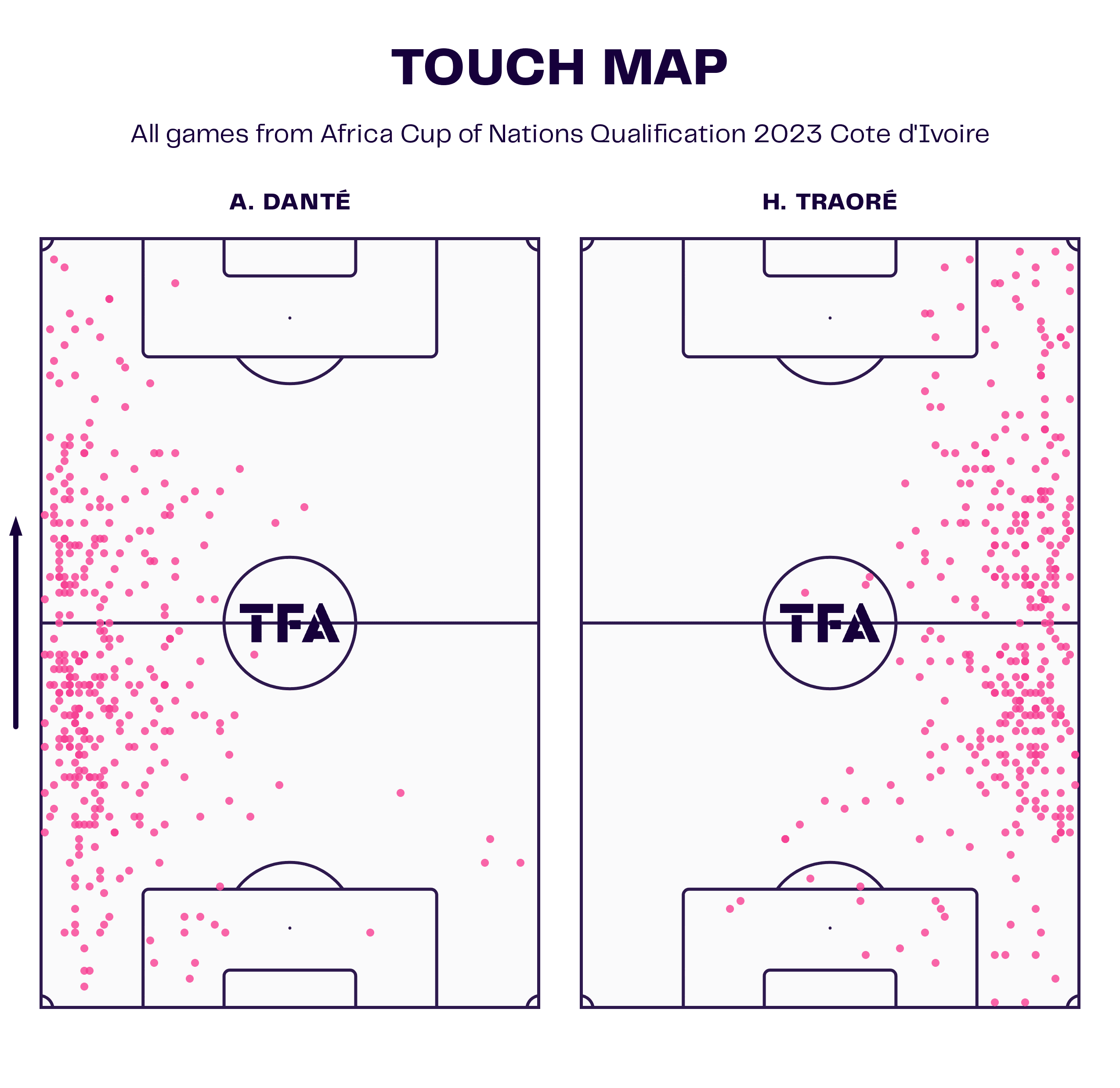
As the touch map above indicates, Mali’s right-back, the experienced Traoré of LaLiga’s Real Sociedad, tends to get forward more than the left-back — this was the case with Dante, as shown in figure 10, and Haïdara.
So, expect more attacking output and an overall threat coming down Mali’s right-wing rather than the left.
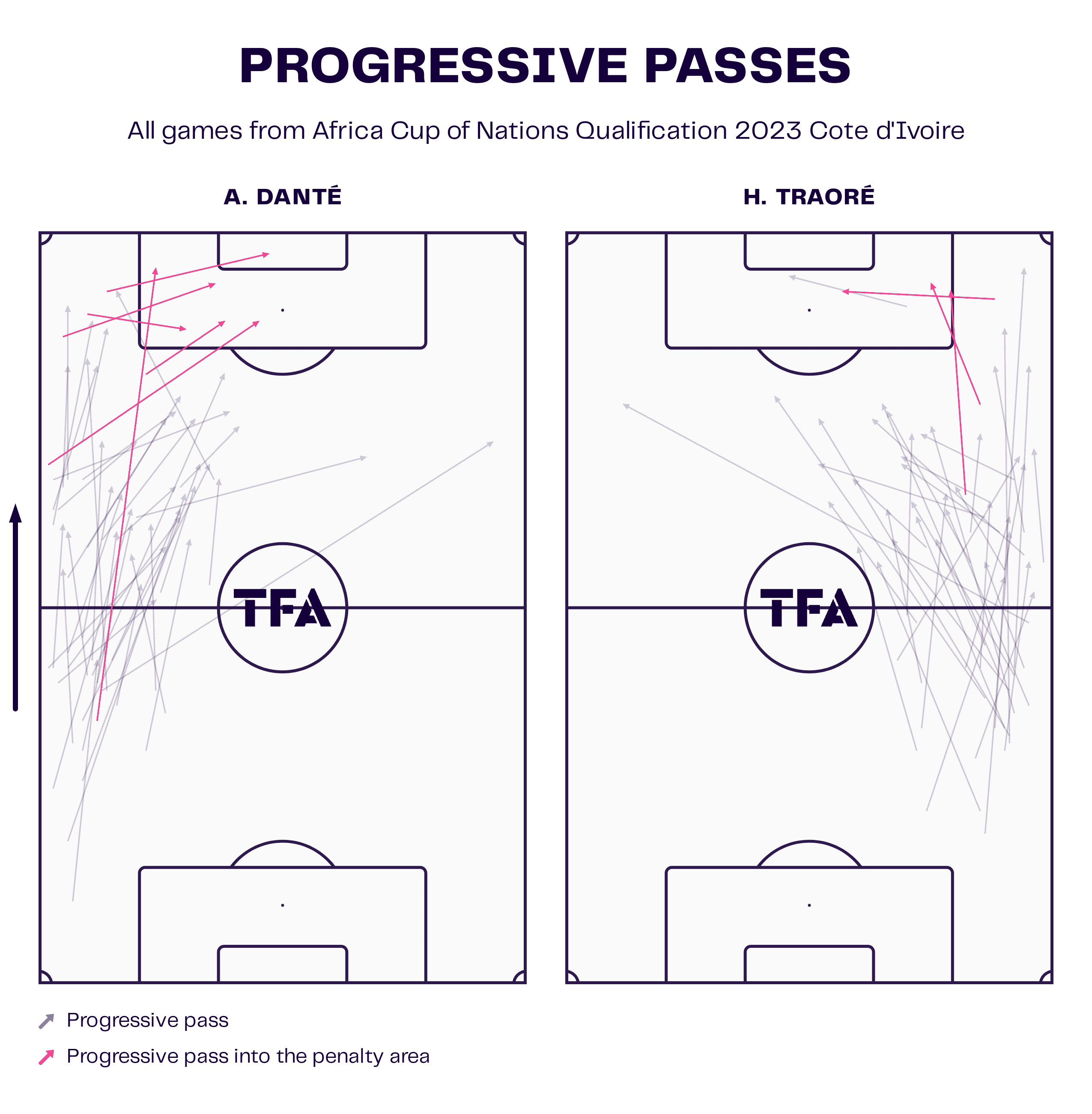
With that said Mali’s full-backs are also vital to the team’s ball progression phase, with a high number of the team’s progressive passes coming through the full-back positions.
Chelle likes his full-backs to play diagonal balls into the centre to find those quality midfielders in space, which they can frequently be relied upon to find. We can see those diagonal balls into the centre coming from both full-backs in figure 11.
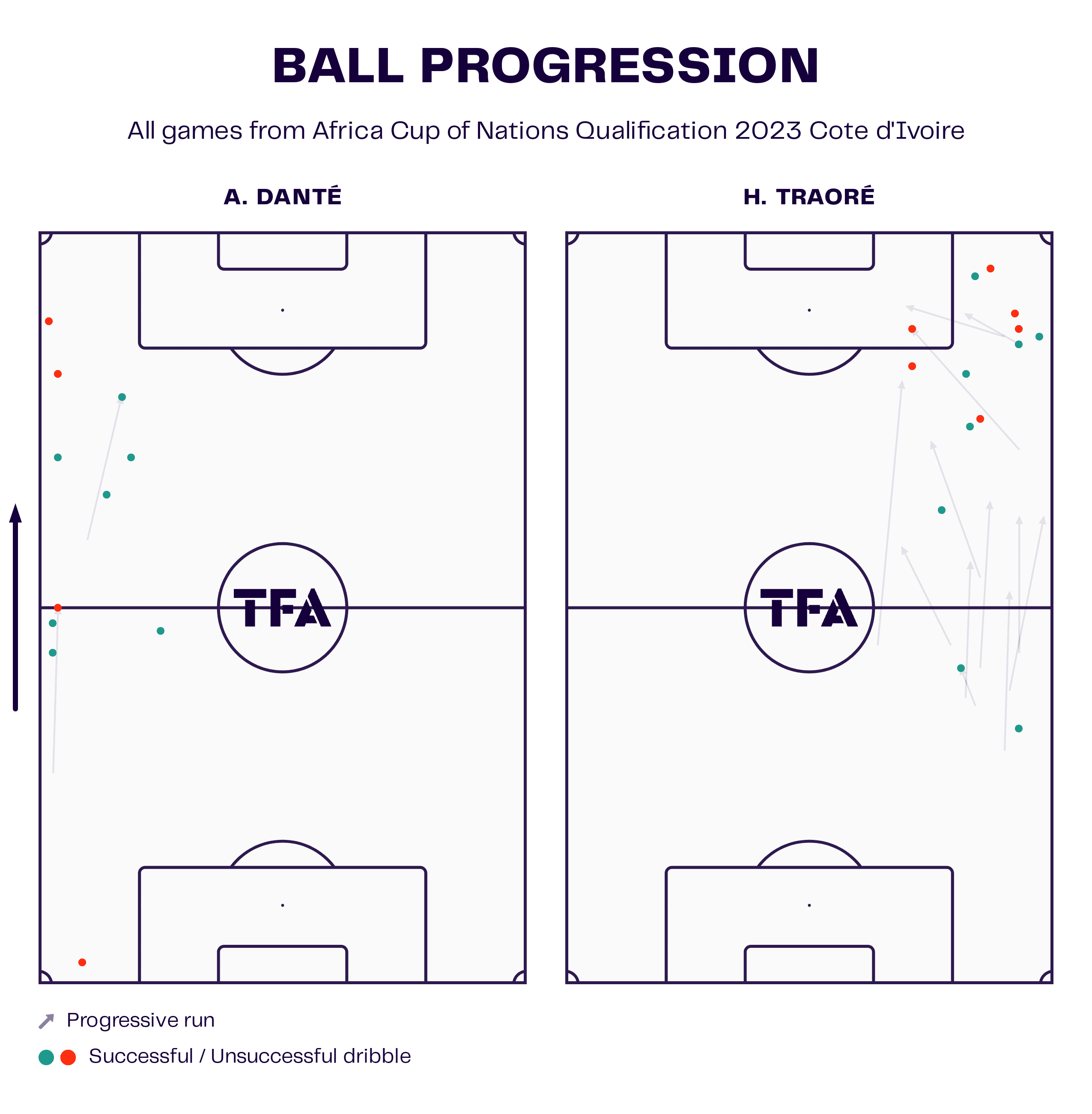
If progressive passes aren’t on, both full-backs are also reliable when carrying forward. They can threaten directly via their runs, either progressing into the final third themselves with a carry or progressing enough to attract a defender and free up a midfielder or more advanced player ahead that they can then find with a forward pass.
Teams often force the ball out to the opponent’s full-backs and press aggressively when it gets there — and that will be the case, at times, with Mali. It’s a vulnerable part of the pitch. However, Mali do tend to use their full-backs intelligently to facilitate ball progression, and they have good quality in those positions, so opponents need to be wary and not approach those full-backs in too casual a way, as they can progress the ball and put attacks in motion that will put teams in danger.
Key player to watch: Kamory Doumbia
Our fourth and final section of analysis will touch on a key Malian player to watch. We’ve chosen to highlight 20-year-old Kamory Doumbia (170cm/5’7, 53kg/117lbs), who joined Brest on a season-long loan from Reims last summer, having initially moved to the Champagne region from Bamako-based Académie JMG in 2021.
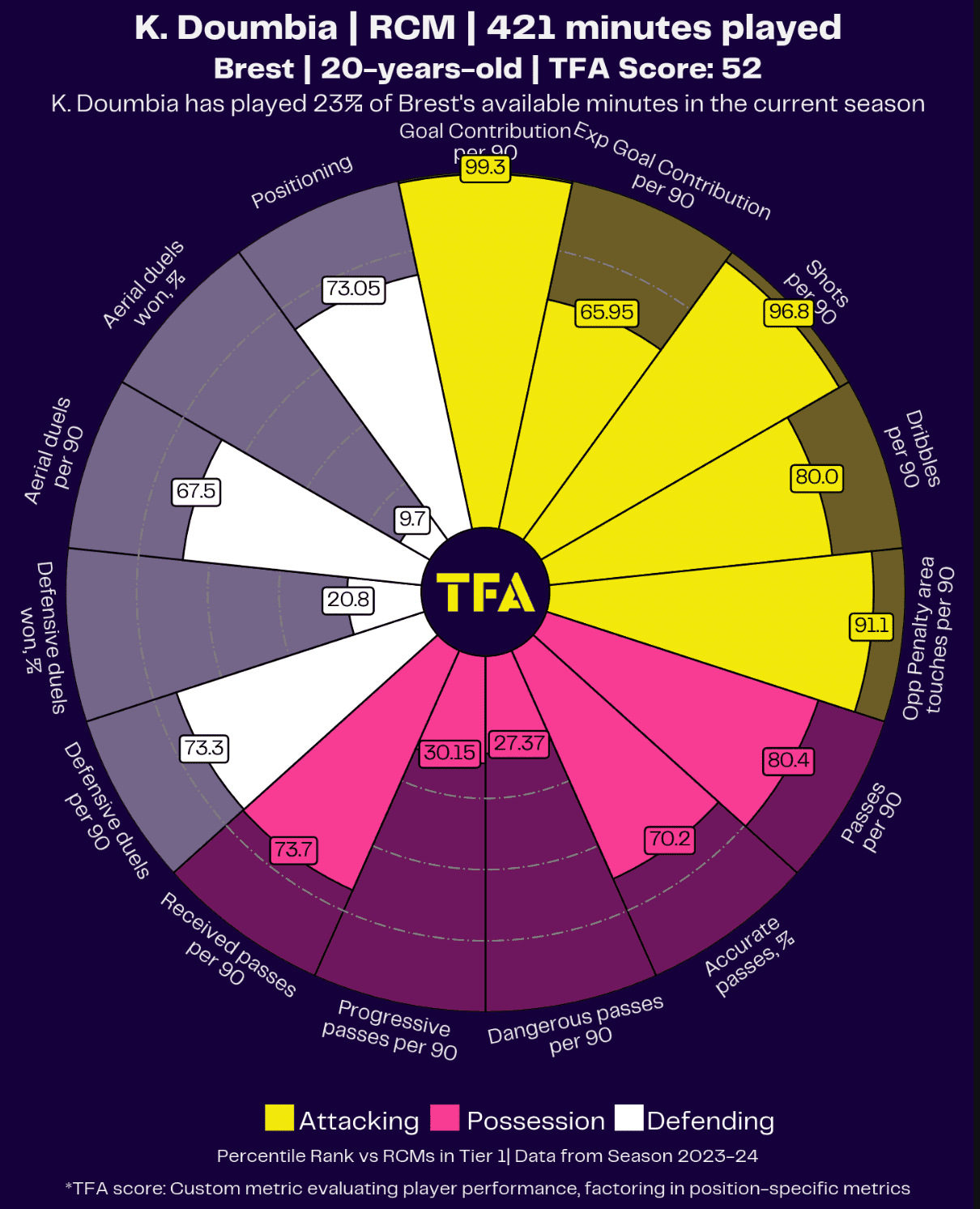
Doumbia has not been a regular starter for Brest this season but has made a massive impact in the minutes he’s been entrusted with — 421 or 23% of all available Ligue 1 minutes at this stage of the season.
Despite getting minimal time on the pitch, largely restricted to cameo appearances, Doumbia has scored five goals and provided two assists in the league this term — boasting a massive percentile rank in the goal contributions per 90 sector of our pizza chart in figure 13, along with a decent ranking in the expected goal contributions per 90 sector.
He takes plenty of shots and makes plenty of dribbles, too, highlighting his high level of output in possession.
Doumbia is also not afraid to get stuck in without the ball, as his percentile ranks in defensive positioning and defensive duels per 90 indicate, making him an ideal fit for Mali’s high pressing from the front.
In a 4-D-2, expect to find Doumbia in the ‘10’ role, while he could appear as a ‘10’ or out wide, depending on tactical preference, in the 4-2-3-1. Of course, should his side utilise a 4-3-3, he’ll be deployed out wide.
With five goals and one assist to his name in eight national team appearances, Doumbia is already making a solid case for himself as an undroppable figure within this Mali side, and he could make this AFCON tournament a breakout one. If he does, expect to see Mali go deep into the competition. He’s certainly a key player within Chelle’s side for opponents to prepare to deal with extensively.
Conclusion
To conclude this tactical analysis and overview of Éric Chelle’s Mali, we expect them to be a formidable outfit for any team in this competition to deal with due to their quality in possession, particularly in the midfield area, aggression and organisation without the ball and some key players who add spark and intangible qualities that every great team needs.
Despite losing Ibrahima Koné to injury, hopes can be high among Mali fans, who may well be understandably optimistic about their team’s chances of going further than the Round of 16 for the first time since 2013. If and when that accomplishment is achieved, who knows what this tournament could hold for this promising team?





Comments